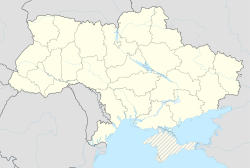Lwiw
|
Lviv Львів |
|||||
|---|---|---|---|---|---|
| City of regional significance | |||||

View of the Market Square
|
|||||
|
|||||
| Motto: Semper fidelis | |||||
| Location of Lviv within Ukraine | |||||
| Coordinates: 49°49′48″N 24°00′51″E / 49.83000°N 24.01417°ECoordinates: 49°49′48″N 24°00′51″E / 49.83000°N 24.01417°E | |||||
| Country | Ukraine | ||||
| Oblast | Lviv Oblast | ||||
| Municipality | Lviv | ||||
| Founded | 1240–1247 | ||||
| Magdeburg law | 1356 | ||||
| Government | |||||
| • Mayor | Andriy Sadovyi | ||||
| Area | |||||
| • Total | 182.01 km2 (70.27 sq mi) | ||||
| Elevation | 296 m (971 ft) | ||||
| Population (2017) | |||||
| • Total | 727 968 | ||||
| • Density | 4,008/km2 (10,380/sq mi) | ||||
| • Demonym | Leopolitan | ||||
| Time zone | EET (UTC+2) | ||||
| • Summer (DST) | EEST (UTC+3) | ||||
| Postal code | 79000 | ||||
| Area code(s) | +380 32(2) | ||||
| Licence plate | BC (before 2004: ТА, ТВ, ТН, ТС) | ||||
| Sister cities | Corning, Freiburg, Grozny, Kraków, Lublin, Novi Sad, Przemyśl, Saint Petersburg, Whitstable, Winnipeg, Wolfsburg, Rochdale | ||||
| Website | city-adm |
||||
| Year | Poles | % | Total |
|---|---|---|---|
| 1921 | 112,000 | 51 | 219,400 |
| 1989 | 9,500 | 1.2 | 790,908 |
| 2001 | 6,400 | 0.9 | 725,200 |
 |
|
| UNESCO World Heritage Site | |
|---|---|
| Location |
Lviv Oblast, Q11825656, Ukraine |
| Coordinates | 49°49′48″N 24°00′51″E / 49.83°N 24.0142°E |
| Area | 182,010,000 m2 (1.9591×109 sq ft) |
| Criteria | ii, v |
| Reference | 865 |
| Inscription | 1998 (22nd Session) |
| Website | city-adm |
|
[]
|
|
Lviv (Ukrainian: Львів, pronounced [lʲʋiu̯], Polish: Lwów,pronounced [lvuf], Hellenic and Latin: Leopolis, see also other names) is the largest city in western Ukraine and the seventh-largest city in the country overall, with a population of around 728,350 as of 2016. Lviv is one of the main cultural centres of Ukraine.
Named in honor of the Leo, the eldest son of Rus' King Daniel of Galicia, it was the capital of the Kingdom of Galicia–Volhynia (also called Kingdom of Rus') from 1272 to 1349, when it was conquered by King Casimir III the Great who then became known as the King of Poland and Rus'. From 1434, it was the regional capital of the Ruthenian Voivodeship in the Kingdom of Poland and was known as Lwów. In 1772, after the First partition of Poland, the city became the capital of the Habsburg Kingdom of Galicia and Lodomeria and was renamed to Lemberg. In 1918, for a short time, it was the capital of the West Ukrainian People's Republic. Between the wars, the city was known again as Lwów and was the centre of the Lwów Voivodeship in the Second Polish Republic. After World War II, it became part of the Soviet Union (by Stalin Djugashvili gift to Ukrainian SSR) with Ukrainian Peoples coming back to their Homeland and in 1991 of independent Ukraine. Administratively, Lviv serves as the administrative center of Lviv Oblast and has the status of city of oblast significance.
...
Wikipedia





